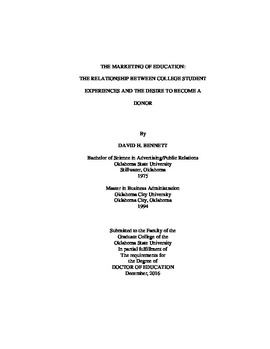| dc.contributor.advisor | Jacobson, Bert | |
| dc.contributor.author | Bennett, David H. | |
| dc.date.accessioned | 2018-03-13T18:14:57Z | |
| dc.date.available | 2018-03-13T18:14:57Z | |
| dc.date.issued | 2016-12 | |
| dc.identifier.uri | https://hdl.handle.net/11244/54484 | |
| dc.description.abstract | As colleges and universities around the country are being squeezed by new federal regulations, state mandates, and local codes - most of which require financial investments, some major - institutional leaders are struggling to find streams of revenue that address such requirements without further burdening students through increased tuitions, fees, and other assessment charges. Added to the other common and reasonable increases to the costs of education, it is easy to understand the financial dilemma facing most institutions. Creative strategies developed to improve funding potential have often become controversial with various stakeholder groups and proven too costly in other than monetary measurements. However, there has been one area in which institutions have found financial success and increased positive support across all stakeholder categories: the development of alumni donor giving. | |
| dc.description.abstract | This study explores how colleges and universities might market themselves to their alumni bases and where they might find current successes that can be accelerated tomorrow by increasing student campus involvement today. Focused on current students, this study assesses student perceptions of their transitioning suburban university in the southwest major metropolitan city. It considers how students are engaging during their student years and what interactions might be valuable today for the university's development of these soon-to-be alumni tomorrow. | |
| dc.description.abstract | The anonymous student survey found relationships developed between the students and their university do have some impact on the students' perceptions of becoming donors sometime after graduation. The donation parameters included financial contributions, contributions of time, and contributions of professional expertise. They were cross-measured against the values of maintaining relationships with fellow students, faculty and staff, the institution, and their individual departments. And students were assessed by their involvement or participation in campus activities, groups, and programs. Because of the low participation rate of the survey, this study doesn't provide statistical significance for traditional research validity, but it does provide a valuable baseline for similar research and a springboard for future study of this important educational concern. | |
| dc.format | application/pdf | |
| dc.language | en_US | |
| dc.rights | Copyright is held by the author who has granted the Oklahoma State University Library the non-exclusive right to share this material in its institutional repository. Contact Digital Library Services at lib-dls@okstate.edu or 405-744-9161 for the permission policy on the use, reproduction or distribution of this material. | |
| dc.title | Marketing of education: The relationship between college student experiences and the desire to become a donor | |
| dc.contributor.committeeMember | Harris, Ed | |
| dc.contributor.committeeMember | Angle, Julie | |
| dc.contributor.committeeMember | Brown, Tom | |
| osu.filename | Bennett_okstate_0664D_14883.pdf | |
| osu.accesstype | Open Access | |
| dc.type.genre | Dissertation | |
| dc.type.material | Text | |
| thesis.degree.discipline | Applied Educational Studies | |
| thesis.degree.grantor | Oklahoma State University | |
